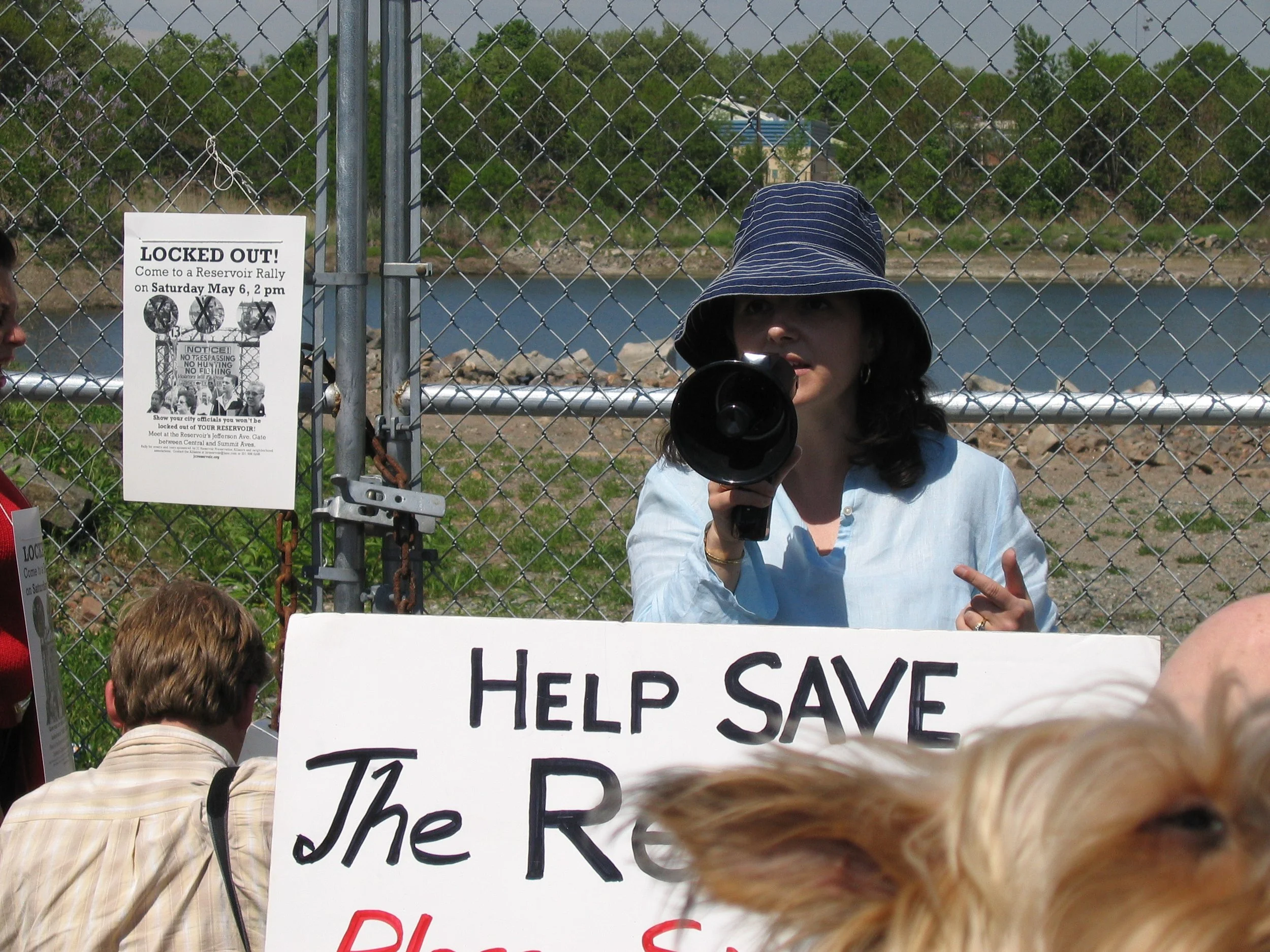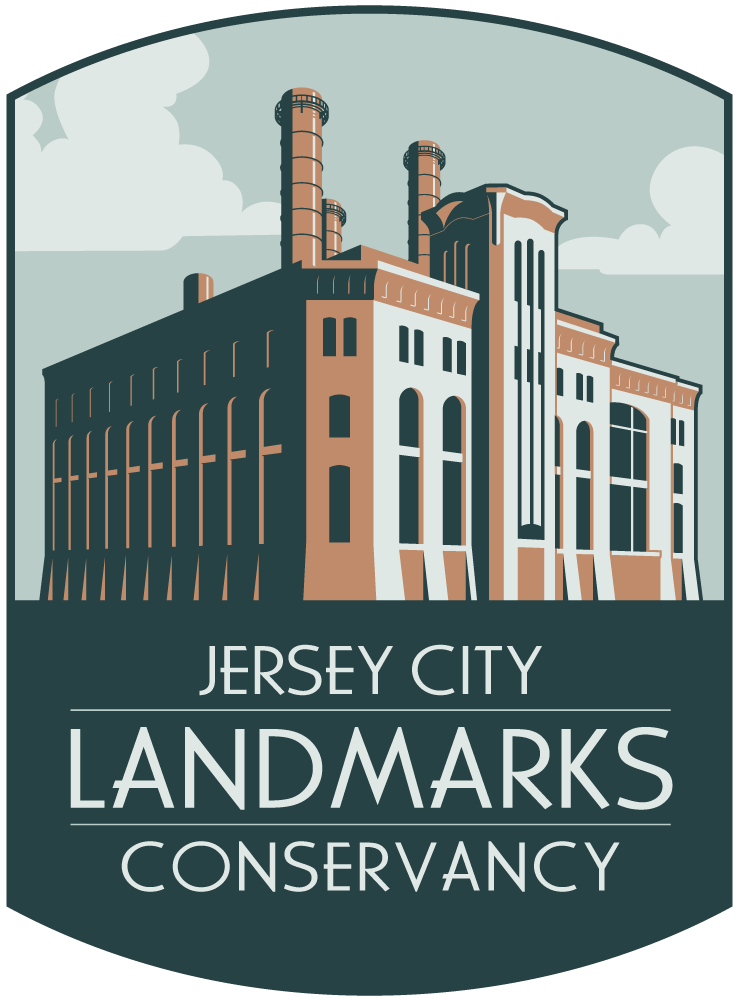Jersey City Reservoir Re-opened: A Critical Response
Jersey City’s historic Reservoir No. 3 was reopened this week to the public after years of largely unexplained closure, with well-dressed hosts of municipal dignitaries gathering on tree-cleared trails to give a handful of media outlets personal excursions. Hand-held TV cameras were carried through artificially graveled paths to capture footage of families strolling and runners hurrying by. Helicopters equipped with digital zoom lenses flew low over the interior lake. The skies were clear, perfect.
Elected officials were not shy in speaking euphorically on camera about the complexities of the project. But no where in their confident comments or prepped sound bites were there mentions of project cost overruns, missed deadlines, botched interventions, and intense clashes between City Hall and the ultimately-ignored, ultimately-disinvited local preservation community.
Even more stunning at the unveiling was how blatantly the Reservoir’s pioneer preservation advocates from the last 35 years were largely left out of the congratulatory narrative. We did not hear enough the names of Herbie Huels, Stevie Latham, Vinnie MacNamara, Cynthia Hadjiyannis — passionate citizens who battled tirelessly against turning the nearly 14-acre site into a vast paved landscape of fenced-off ballfields, paid municipal lots, parking-decked supermarkets, and over-scaled luxe high rises. (Some of these pioneer advocates were mentioned, we are told, by non-municipal attendees at the re-opening, and, were it not for their sense of appreciation, the efforts of these early Reservoir legends would have been absent in the spirit of the moment.)














Above gallery: In 2006 the Jersey City Reservoir Preservation Alliance (JCRPA) organized a public UNLOCK THE RESERVOIR demonstration at City Hall on Grove Street, later walking up the hill to the Reservoir, which the municipal government had just padlocked in anticipation of the development of the oasis into ballfields with commercial and private buildings. The JCRPA drew hundreds to both locations of the demonstration — seniors, long-time residents, new residents, families, children, students, civil rights activists, and local preservation and environmental groups. A few days later, with the Reservoir issue still rocking lawmakers in the media, City Hall capitulated and — almost overnight — gave the new keys to the Alliance and promised to work toward repurposing the site into passive space. The demonstration event in 2006 was not without drama as speakers blasted out impassioned words on bullhorns, with police officers showing up as the crowd swelled with participants and vehicles.
Kept from the press at the 2024 re-opening were project details that have long frustrated, disappointed, and agitated the preservation community, including:
Erecting a new foot bridge forged from environmentally damaging materials like steel and concrete instead of more sustainable and environmentally sensitive materials, such as timber from responsibly managed forests. While necessary for creating a continuous walking path across the site’s upper perimeter, the new bridge is jarringly out of place and misses the environmental mark spectacularly. (And not once was it pointed out that City Hall was responsible for breaching the Reservoir walls in the late 1990s in order to bring huge dump trucks onto the pump-drained site for what was eventually determined to be toxic soils from surrounding demolition and remediation sites.) During the new bridge’s planning and design stages, Jersey City could have looked across the Hudson River to Manhattan’s High Line park, where a stunning timber truss foot bridge has recently been installed to rave reviews for its beauty, function, and high regard for the environment. Read the Jersey City Reservoir Preservation Alliance comments regarding the new bridge
Pouring a cementitious gravel material on top of the original (circa-1880) elevated dirt paths, giving the entire squared stretch of new walkway a sterilized, unnatural appearance. Before pouring the matrix, mature trees were leveled and cut back, thus erasing decades of sumptuous growth. The pleas of preservationists — namely the Jersey City Reservoir Preservation Alliance (JCRPA), which was formed in 2002 to give voice to the precious Jersey City Heights resource being hungrily eyed by developers — were summarily ignored about this element of the project as well.
The ancient structures extant inside Reservoir No. 3 — two crumbling pump houses, rusting service pipes, and a now-roofless water tower — are deteriorating rapidly, and preservationists have strongly criticized City Hall for dropping the ball on time-sensitive preservation grants, not working diligently with commissioned architecture and engineering firms, and frustratingly sitting on capital improvement allocations. In the meantime these pivotal Reservoir No. 3 structures and objects remain structurally unstable and susceptible to further material loss.
City Hall has shamefully kept the JCRPA at arm’s length and in the dark about decisions and courses of action, a tactic it has used before when dealing with grassroots preservation organizations that suggest alternative and more sensitive and responsible preservation strategies. In recent months the JCRPA has publicly chastised City Hall for the way it has handled the most vital project contracts, made numerous mistakes in site management and messaging, and dismissed the opinions of JCRPA board members — all professionals and specialists in their fields, including landscape architecture and preservation law.
Above Jersey City Landmarks Conservancy gallery: In 2006 the Jersey City Reservoir Preservation Alliance (JCRPA) installed interpretive signs on Reservoir No. 3's dirt trails to inform visitors about the site's cultural resources. The JCRPA was once permitted full access to the site via annual leases with City Hall and offered original educational programming. In the 2000s the JCRPA organized popular events, including fishing derbies, pet days, meditation and mindfulness sessions, photography lessons, kayaking, boating, and birdwatching. As of September 2024, this community-minded arrangement is virtually non-existent.
While the reopening of Reservoir No. 3 is definitely a positive for Jersey City — reopening it has been the JCRPA’s goal since 2002 — City Hall needs to edit the narrative it has created for its own political ends. It must immediately start to credit those who saved the site at a time when no one wanted to save it. (Perhaps it can put up historical signage on the trails; name sections after pioneers; dedicate restored buildings in their honor.) It needs, moving forward, to allow the JCRPA to curate, program, and manage the site in its entirety; drive the stabilization and restoration phases of the extant historic structures; and be re-invited (permanently) to the preservation table for meaningful collaboration.
Additional issues with City Hall’s treatment of the historic site:
The fencing used in the Reservoir’s restoration is the same utilitarian fencing we are seeing in virtually every Jersey City park — hollow, tubular, stark black, inexpensive, lacking character and lacking style. The Reservoir, being singular and unlike any park space in Jersey City, should have had a fencing program more sensitive to the site’s natural and historical landscape. Instead this Public Works-style fencing was plunked down on poured-concrete footings and in some stretches obstructs views of the lake and surrounding streetscapes. Some areas of the Reservoir are over-fenced.
The slurry walls, soil beds, and earthworks near the new bridge were not treated sensitively during construction. Entire elevations of original wall were leveled, with monumental stones being scattered and piled up at the base to create artificial barriers (or so it seems). Concerns and protestations were raised during this phase by preservationists about the loss of architectural integrity as well as the extent of environmental impacts — but they were ignored.
Those who know the Reservoir’s urban-escape topography — untouched and undisturbed until these recent interventions — the site, as it is right now, is a stripped down version of itself. The upper embankments are now a long cinder track and no longer a shaded oasis filled with private pockets and surprise eruptions of greenery. People walking above the streets today are in full view now, in full sun.
The seats placed the major turns and crossings of the elevations are the same benches we see in every Jersey City park. Just a few years ago the Reservoir had stone settees on the trails dedicated by local youth scouts. Only one remains — what happened to the others?
The original Reservoir fencing along Pershing Plaza was taken out, and the old Reservoir signs that were affixed to it are now gone as well. Why weren’t these signs retained as Reservoir artifacts for future exhibition in one of the ancient pump houses, should there ever be visitor centers?
Above photo gallery: The new steel bridge at Reservoir No. 3 in Jersey City vs. the new and environmentally responsible timber truss bridge at The High Line in Manhattan
No one can imagine Central Park without the planning and governance of the Central Park Conservancy; the High Line without the Friends of the High Line; Liberty State Park without the Friends of Liberty State Park; Governor’s Island without The Trust for Governors Island; the Harsimus Embankment without the Embankment Preservation Coalition. Reducing the civic role and cultural importance of the Jersey City Reservoir Preservation Alliance — a non-profit, all-volunteer organization that proved its worth years ago — and keeping them out of critical Reservoir planning and programming is an insult to grassroots preservation in Jersey City.
Above Jersey City Landmarks Conservancy photo gallery: Reservoir No. 3 on Saturday, September 21, 2024

















































